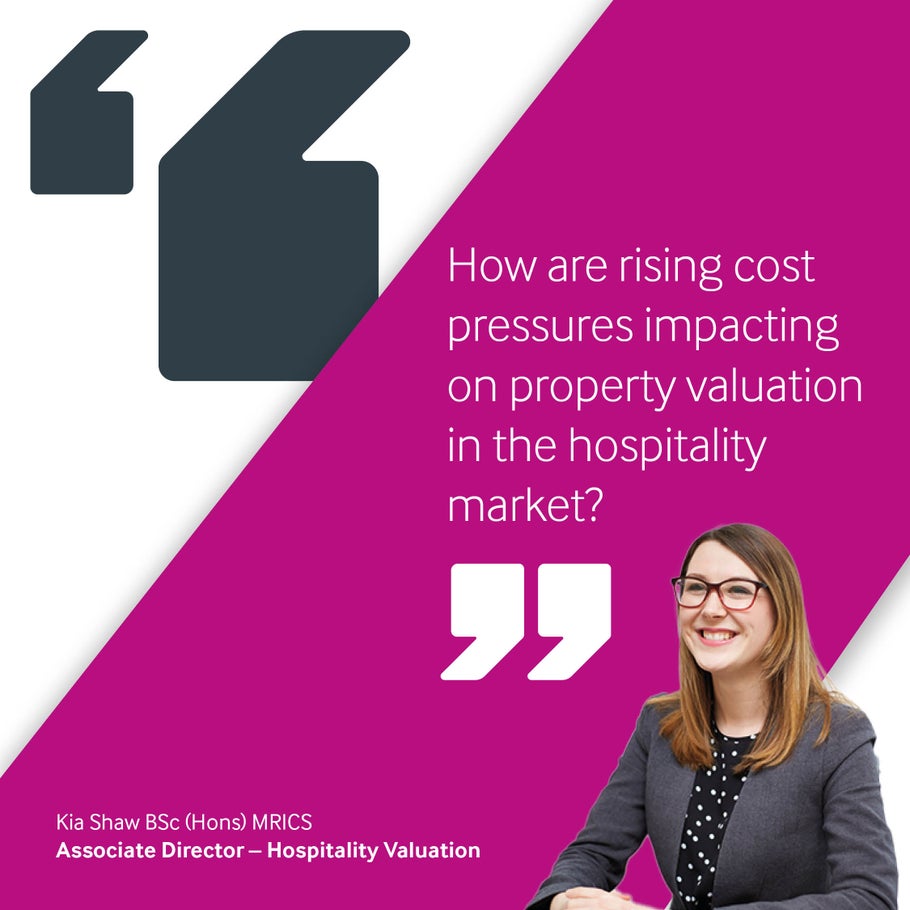Rising Cost Pressures: How are they impacting valuations?
Media headlines are currently dominated by the issue of rising costs and the increasing financial pressures facing consumers and businesses due to the cost-of-living crisis. Inflation levels reached a record high in April 2022, bolstered by rising consumer goods and fuel costs, which has been further exacerbated by the ongoing war in Ukraine. Simultaneously, staffing costs are also rising due to staff shortages and increases in the National Living Wage; all of which are putting a strain on businesses, impacting the hospitality market and the way we value businesses within the sector.
Business. Built around You.
Your expert business property advisers


For many operators right now, rising costs are starting to eat into profits, but does this subsequently equate to a lower market value for your business? To consider this, lets first consider the Profits Method and how assessments of value are formed for trading entities.
What is the Profits Method of valuation?
As a Valuation team who specialise in hospitality trading businesses, a large proportion of the properties we value, such as public houses and hotels, are done so on the Profits Method of valuation. The Profits Method, as the name implies, is based on the Fair Maintainable Operating Profit achievable at a property. The essential characteristic of this type of property is that it has been designed or adapted for a specific use, and as a result the value of the property is intrinsically linked to the returns that an owner can generate from that use.
The Profits Method is essentially a two stepped process; firstly, trade is assessed, and an assessment of Fair Maintainable Turnover and Fair Maintainable Operating Profit (FMOP) is formed. Secondly a multiple is applied to the calculated FMOP to establish the Market Value.
Step 1 – Forming an Assessment of Trade
In order to form an assessment of trade, a valuer considers the business’s current, past and future financial performance. Normally this is via an analysis of the last three years of financial accounts. Typically, this is the best indication of trade performance, however we also benchmark against other businesses to ascertain the level of trade that a Reasonably Efficient Operator should be able to achieve.
In the current market, the accounts provided are of course backwards looking and are yet to reflect the rapid rise in costs over the last six months. Moreover, the impact may not be evidenced in the financials for another 12/18 months. Despite this, we know from our discussions with operators that the impact of rising costs is increasing but this evidence is anecdotal, and the actual impact is unknown at this stage.
To further complicate things, the last three years have been impacted by Covid-19 and the stop-start nature of trading due to social distancing measures. As we have emerged from the pandemic, not all businesses have performed the same with some trading well above pre-pandemic levels, particularly those exposed to the “staycation” market or those with a premium offering who have been able to capture consumers looking to treat themselves after having had nearly two years of restrictions. Operations in city centres and transport hubs have fared less well as workers have been slow to return to offices at pre-pandemic occupancy levels.
The financials we are seeing for the 2020/2021 period are therefore fairly redundant, i.e. the building may have been closed thus energy bills appear low or alternatively the business may have benefitted positively from the temporary VAT discounts , skewing the figures further.
Past performance is therefore not necessarily a guarantee of future performance.
This raises the question: How is the Valuation team reflecting rising costs in our assessment of trade?
Detailed discussions with operators regarding their perception of rising costs is the best starting point. Some may be impacted more so than others. For instance, an operator of a modern purpose-built hotel constructed with eco-technology may be less worried about rising energy costs than say an operator of a Grade II listed converted castle hotel that is powered by oil and has timber, single-glazed windows. In one of our recent cases, we had an operator proudly inform us that they had locked into their energy contract and that the rates were not due to rise for three more years. As such, the rising energy crisis was not of great concern to them.
What about rising staff costs?
With regards to staffing costs, it is somewhat easier to gauge the increases. Often, we request staffing schedules that help us determine the gross external wage bill and generally this is a useful barometer, although not in all cases. For instance, the Lake District has struggled for a long time with attracting and retaining staff so whilst we know roughly what a Head Chef is paid, in the current market a substantial premium may be warranted to attract the right staff member.
As a result, it ultimately comes down to the valuer’s judgement and a detailed and granular approach is necessary. Our team are leading specialists in the hospitality sector who inspect hundreds of properties each year and have access to thousands of businesses’ accounts. We are therefore well placed to read the market and form an appropriate assessment of fair maintainable trade.
The latest report that Christie & Co has worked on in collaboration with leading industry body, UKHospitality, 'The UKH Christie & Co Benchmarking Report 2022' also provides a comprehensive benchmark and indicative data on the impacts of rising costs on over 5,000 hospitality businesses in the six months leading up to December 2021, as the sector emerged from one of the most challenging periods in its history, which we can utilise to guide our assessments of trade.
Step 2 – Applying a Multiple
Once our assessment of fair maintainable trade has been established, the second step is to apply a multiplier (YP) which reflects the number of years required for a property to yield its price. Multipliers are derived from comparable market transactions.
What are transactions telling us about market values?
The hospitality market generally remains strong. Our brokers are continuing to see more demand than supply and we are yet to see a notable wave of distress.
The overall picture is that market values remain stable. In fact, in many of our sectors there has been growth in values, and we are not yet seeing a negative impact from the pending decline in profit levels. We are of the opinion that a reasonable purchaser would consider the rising costs when acquiring a property – as rising costs are no secret. As a result, this would suggest a general growth in multiples across the market to counteract the cost issues.
Of course, this is only the current trend. So, what are our future market predictions?
The last two years have proved that making predictions is a difficult game. The hospitality market has seen significant structural change, but the sector has emerged as robust and resilient.
We anticipate distress from the latter half of 2022 onwards as cost pressures begin to take their toll on businesses. Historically an operator may have been able to wait for the market to balance out, with income increasing in line with costs. However, in a post-covid market this may not be achievable for many operators who used all of their savings to ride the wave of the pandemic.
In short, each valuation needs to be assessed on a case-by-case basis and in a market where there are so many moving parts it has never been as important to engage a valuer who is experienced in the sector and has access to detailed comparable evidence, both transactional and trading.